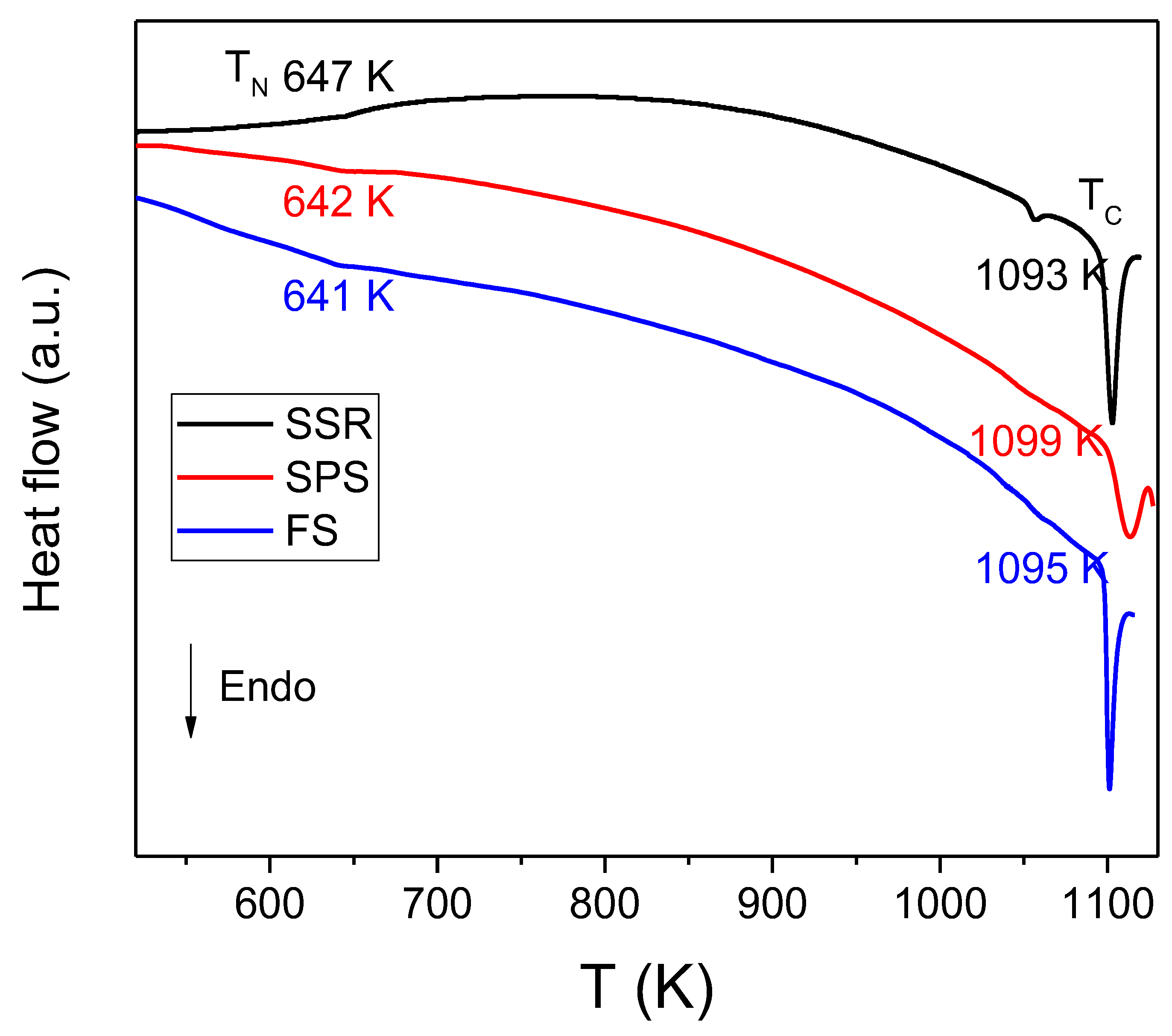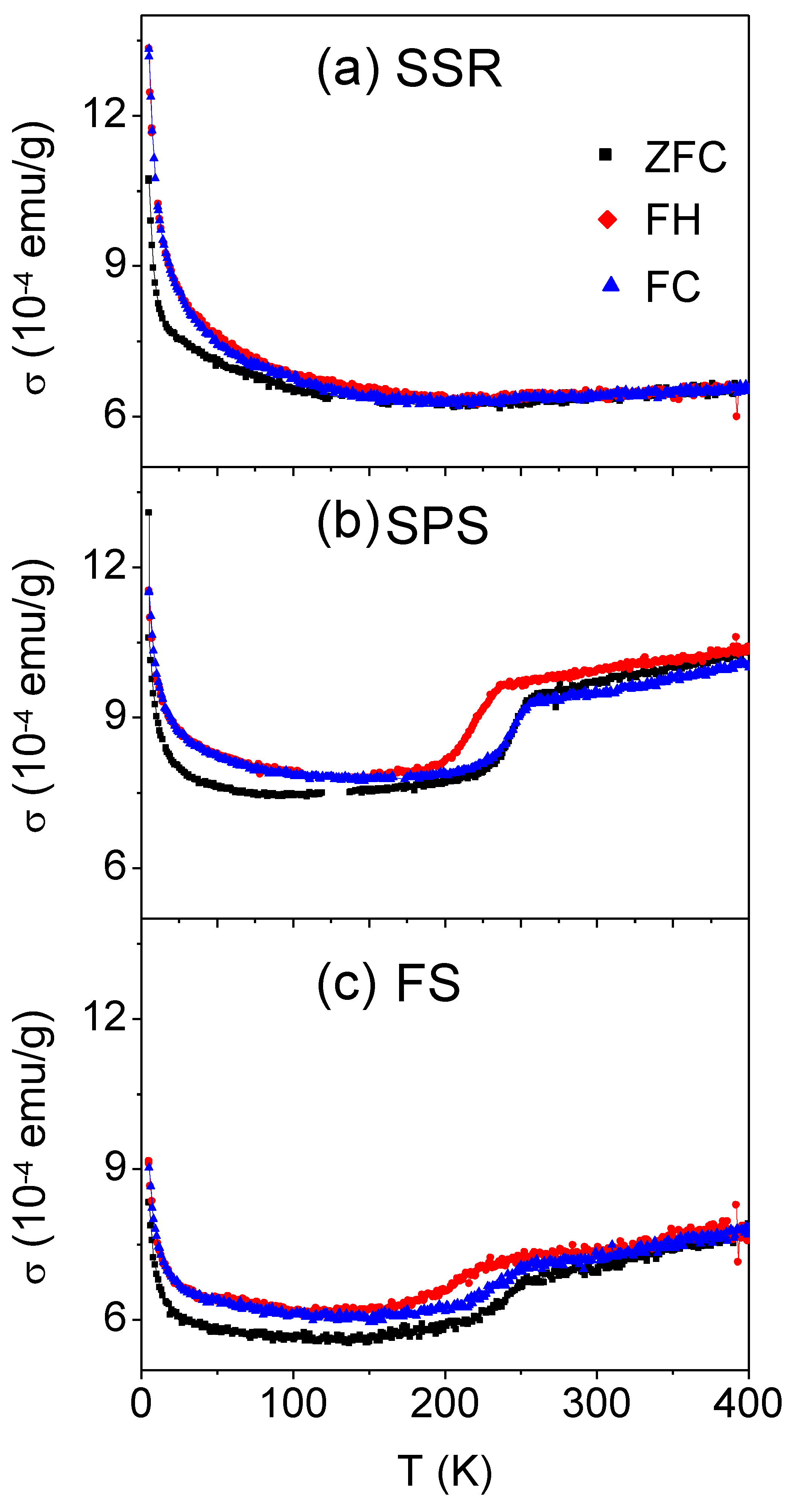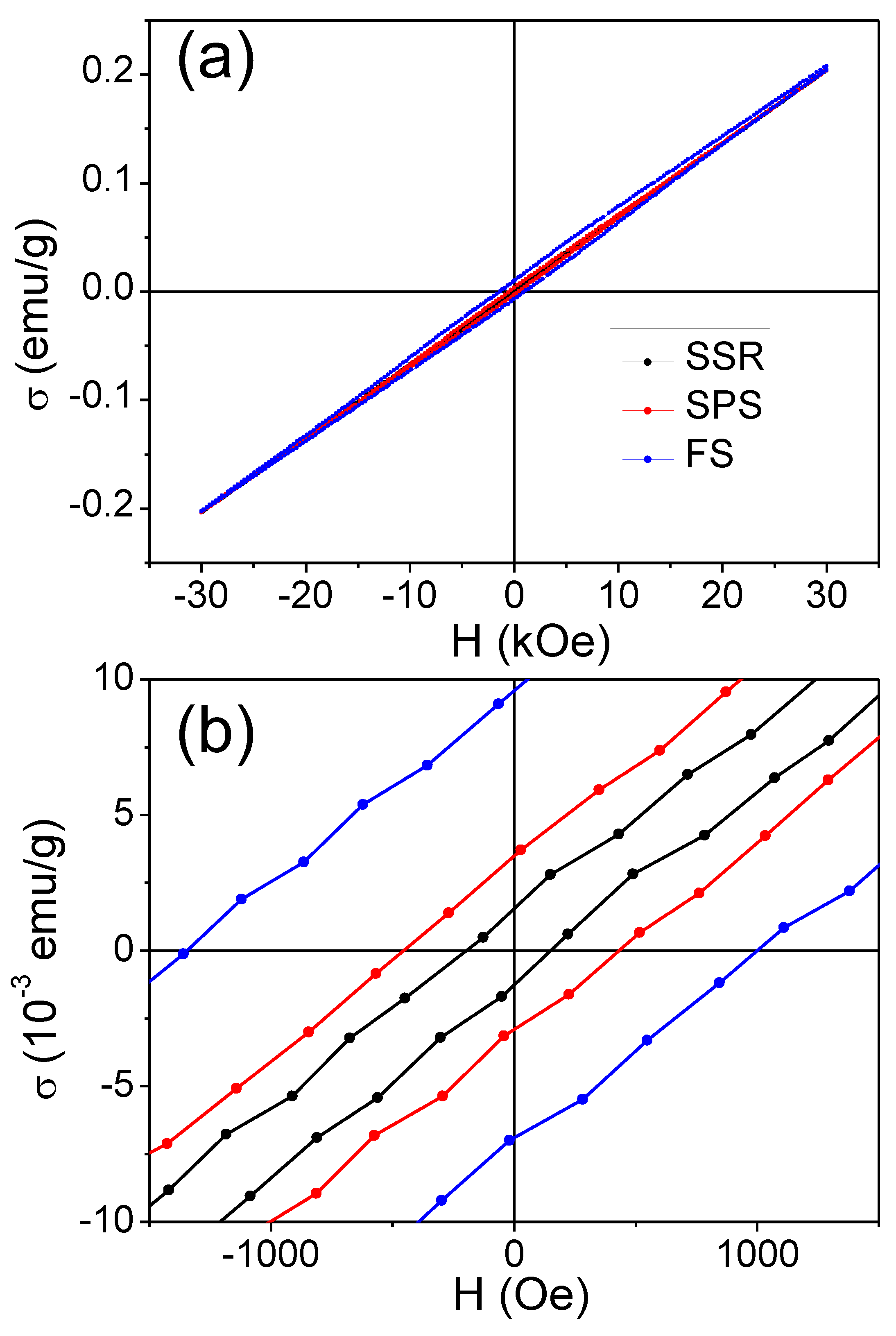Low Temperature Magnetic Transition of BiFeO3 Ceramics Sintered by Electric Field-Assisted Methods: Flash and Spark Plasma Sintering
Abstract
:1. Introduction
2. Materials and Methods
3. Results and Discussion
4. Conclusions
Supplementary Materials
Author Contributions
Funding
Institutional Review Board Statement
Data Availability Statement
Conflicts of Interest
References
- Wu, J.; Fan, Z.; Xiao, D.; Zhu, J.; Wang, J. Multiferroic bismuth ferrite-based materials for multifunctional applications: Ceramic bulks, thin films and nanostructures. Prog. Mater. Sci. 2016, 84, 335–402. [Google Scholar]
- Zhang, F.; Zeng, X.; Bi, D.; Guo, K.; Yao, Y.; Lu, S. Dielectric, ferroelectric, and magnetic properties of Sm-doped BiFeO3 ceramics prepared by a modified solid-state-reaction method. Materials 2018, 11, 2208. [Google Scholar] [CrossRef] [PubMed] [Green Version]
- Kubel, F.; Schmid, H. Structure of a ferroelectric and ferroelastic monodomain crystal of the perovskite BiFeO3. Acta Crystallogr. Sect. B Struct. Sci. 1990, 46, 698–702. [Google Scholar] [CrossRef] [Green Version]
- Catalan, G.; Scott, J.F. Physics and applications of bismuth ferrite. Adv. Mater. 2009, 21, 2463–2485. [Google Scholar] [CrossRef]
- Rojac, T.; Bencan, A.; Malic, B.; Tutuncu, G.; Jones, J.L.; Daniels, J.E.; Damjanovic, D. BiFeO3 ceramics: Processing, electrical, and electromechanical properties. J. Am. Ceram. Soc. 2014, 97, 1993–2011. [Google Scholar] [CrossRef]
- Muneeswaran, M.; Dhanalakshmi, R.; Giridharan, N.V. Structural, vibrational, electrical and magnetic properties of Bi1−xPrxFeO3. Ceram. Int. 2015, 41, 8511–8519. [Google Scholar] [CrossRef]
- Schrade, M.; Masó, N.; Perejón, A.; Pérez-Maqueda, L.A.; West, A.R. Defect chemistry and electrical properties of BiFeO3. J. Mater. Chem. C 2017, 5, 10077–10086. [Google Scholar] [CrossRef] [Green Version]
- Wang, Y.P.; Zhou, L.; Zhang, M.F.; Chen, X.Y.; Liu, J.M.; Liu, Z.G. Room-temperature saturated ferroelectric polarization in BiFeO3 ceramics synthesized by rapid liquid phase sintering. Appl. Phys. Lett. 2004, 84, 1731–1733. [Google Scholar] [CrossRef]
- Das, S.R.; Choudhary, R.N.P.; Bhattacharya, P.; Katiyar, R.S.; Dutta, P.; Manivannan, A.; Seehra, M.S. Structural and multiferroic properties of La-modified BiFeO3 ceramics. J. Appl. Phys. 2007, 101, 034104. [Google Scholar] [CrossRef]
- Perejón, A.; Masó, N.; West, A.R.; Sánchez-Jiménez, P.E.; Poyato, R.; Criado, J.M.; Pérez-Maqueda, L.A. Electrical properties of stoichiometric BiFeO3 prepared by mechanosynthesis with either conventional or spark plasma sintering. J. Am. Ceram. Soc. 2013, 96, 1220–1227. [Google Scholar] [CrossRef] [Green Version]
- Ederer, C.; Spaldin, N.A. Weak ferromagnetism and magnetoelectric coupling in bismuth ferrite. Phys. Rev. B 2005, 71, 060401. [Google Scholar] [CrossRef]
- Suresh, P.; Srinath, S. Effect of La substitution on structure and magnetic properties of sol-gel prepared BiFeO3. J. Appl. Phys. 2013, 113, 17D920. [Google Scholar] [CrossRef]
- Zhang, Y.; Wang, Y.; Qi, J.; Tian, Y.; Sun, M.; Zhang, J.; Yang, J. Enhanced magnetic properties of BiFeO3 thin films by doping: Analysis of structure and morphology. Nanomaterials 2018, 8, 711. [Google Scholar] [CrossRef] [PubMed] [Green Version]
- Bai, L.; Sun, M.; Ma, W.; Yang, J.; Zhang, J.; Liu, Y. Enhanced magnetic properties of co-doped BiFeO3 thin films via structural progression. Nanomaterials 2020, 10, 1798. [Google Scholar] [CrossRef]
- Tian, Y.; Fu, Q.; Xue, F.; Zhou, L.; Wang, C.; Gou, H.; Zhang, M. Enhancement of dielectric and magnetic properties in phase pure, dense BiFeO3 nanoceramics synthesized by spark plasma sintering techniques. J. Mater. Sci. Mater. Electron. 2018, 29, 17170–17177. [Google Scholar] [CrossRef]
- Park, T.J.; Papaefthymiou, G.C.; Viescas, A.J.; Moodenbaugh, A.R.; Wong, S.S. Size-dependent magnetic properties of single-crystalline multiferroic BiFeO3 nanoparticles. Nano Lett. 2007, 7, 766–772. [Google Scholar] [CrossRef]
- Karoblis, D.; Griesiute, D.; Mazeika, K.; Baltrunas, D.; Karpinsky, D.V.; Lukowiak, A.; Kareiva, A. A facile synthesis and characterization of highly crystalline submicro-sized BiFeO3. Materials 2020, 13, 3035. [Google Scholar] [CrossRef]
- Semchenko, A.V.; Sidsky, V.V.; Bdikin, I.; Gaishun, V.E.; Kopyl, S.; Kovalenko, D.L.; Kholkin, A.L. Nanoscale Piezoelectric Properties and Phase Separation in Pure and La-Doped BiFeO3 Films Prepared by Sol–Gel Method. Materials 2021, 14, 1694. [Google Scholar] [CrossRef]
- Munir, Z.A.; Anselmi-Tamburini, U.; Ohyanagi, M. The effect of electric field and pressure on the synthesis and consolidation of materials: A review of the spark plasma sintering method. J. Mater. Sci. 2006, 41, 763–777. [Google Scholar] [CrossRef]
- Olevsky, E.; Dudina, D. Field-Assisted Sintering Science and Applications; Springer: Berlin/Heidelberg, Germany, 2018. [Google Scholar] [CrossRef]
- Guillon, O.; Gonzalez-Julian, J.; Dargatz, B.; Kessel, T.; Schierning, G.; Räthel, J.; Herrmann, M. Field-assisted sintering technology/spark plasma sintering: Mechanisms, materials, and technology developments. Adv. Eng. Mater. 2014, 16, 830–849. [Google Scholar] [CrossRef] [Green Version]
- Cologna, M.; Rashkova, B.; Raj, R. Flash Sintering of Nanograin Zirconia in <5 s at 850 °C. J. Am. Ceram. Soc. 2010, 93, 3556–3559. [Google Scholar]
- Song, S.H.; Zhu, Q.S.; Weng, L.Q.; Mudinepalli, V.R. A comparative study of dielectric, ferroelectric and magnetic properties of BiFeO3 multiferroic ceramics synthesized by conventional and spark plasma sintering techniques. J. Eur. Ceram. Soc. 2015, 35, 131–138. [Google Scholar] [CrossRef]
- Perez-Maqueda, L.A.; Gil-Gonzalez, E.; Perejon, A.; Lebrun, J.M.; Sanchez-Jimenez, P.E.; Raj, R. Flash sintering of highly insulating nanostructured phase-pure BiFeO3. J. Am. Ceram. Soc. 2017, 100, 3365–3369. [Google Scholar] [CrossRef]
- Gil-González, E.; Pérez-Maqueda, L.A.; Sánchez-Jiménez, P.E.; Perejón, A. Flash Sintering Research Perspective: A Bibliometric Analysis. Materials 2022, 15, 416. [Google Scholar] [CrossRef]
- Singh, M.K.; Prellier, W.; Singh, M.P.; Katiyar, R.S.; Scott, J.F. Spin-glass transition in single-crystal BiFeO3. Phys. Rev. B 2008, 77, 144403. [Google Scholar] [CrossRef]
- Das, B.K.; Ramachandran, B.; Dixit, A.; Rao, M.R.; Naik, R.; Sathyanarayana, A.T.; Amarendra, G. Emergence of two-magnon modes below spin-reorientation transition and phonon-magnon coupling in bulk BiFeO3: An infrared spectroscopic study. J. Alloy. Compd. 2020, 832, 154754. [Google Scholar] [CrossRef]
- Vijayanand, S.; Mahajan, M.B.; Potdar, H.S.; Joy, P.A. Magnetic characteristics of nanocrystalline multiferroic BiFeO3 at low temperatures. Phys. Rev. B 2009, 80, 064423. [Google Scholar] [CrossRef]
- Scott, J.F.; Singh, M.K.; Katiyar, R.S. Critical phenomena at the 140 and 200 K magnetic phase transitions in BiFeO3. J. Phys. Condens. Matter 2008, 20, 322203. [Google Scholar] [CrossRef]
- Redfern, S.A.T.; Wang, C.; Hong, J.W.; Catalan, G.; Scott, J.F. Elastic and electrical anomalies at low-temperature phase transitions in BiFeO3. J. Phys. Condens. Matter 2008, 20, 452205. [Google Scholar] [CrossRef] [Green Version]
- Weber, M.; Guennou, M.; Toulouse, C.; Cazayous, M.; Gillet, Y.; Gonze, X.; Kreisel, J. Temperature evolution of the band gap in BiFeO3 traced by resonant Raman scattering. Phys. Rev. B 2016, 93, 125204. [Google Scholar] [CrossRef] [Green Version]
- Perejón, A.; Murafa, N.; Sánchez-Jiménez, P.E.; Criado, J.M.; Subrt, J.; Dianez, M.J.; Pérez-Maqueda, L.A. Direct mechanosynthesis of pure BiFeO3 perovskite nanoparticles: Reaction mechanism. J. Mater. Chem. C 2013, 1, 3551–3562. [Google Scholar] [CrossRef]
- Palai, R.; Katiyar, R.; Schmid, H.; Tissot, P.; Clark, S.; Robertson, J.; Redfern, S.; Catalan, G.; Scott, J. βphase and γ-β metal-insulator transition in multiferroic BiFeO3. Phys. Rev. B 2008, 71, 014110. [Google Scholar] [CrossRef] [Green Version]
- Perejon, A.; Sanchez-Jimenez, P.E.; Criado, J.M.; Perez-Maqueda, L.A. Thermal stability of multiferroic BiFeO3: Kinetic nature of the β–γ transition and peritectic decomposition. J. Phys. Chem. C 2014, 118, 26387–26395. [Google Scholar] [CrossRef]
- Fischer, P.; Polomska, M.; Sosnowska, I.; Szymanski, M. Temperature dependence of the crystal and magnetic structures of BiFeO3. J. Phys. C Solid State Phys. 1980, 13, 1931. [Google Scholar] [CrossRef]
- Pikula, T.; Szumiata, T.; Siedliska, K.; Mitsiuk, V.I.; Panek, R.; Kowalczyk, M.; Jartych, E. The Influence of Annealing Temperature on the Structure and Magnetic Properties of Nanocrystalline BiFeO3 Prepared by Sol–Gel Method. Metall. Mater. Trans. A 2022, 53, 470–483. [Google Scholar] [CrossRef]
- Wei, J.; Wu, C.; Yang, T.; Lv, Z.; Xu, Z.; Wang, D.; Cheng, Z. Temperature-driven multiferroic phase transitions and structural instability evolution in lanthanum-substituted bismuth ferrite. J. Phys. Chem. C 2019, 123, 4457–4468. [Google Scholar] [CrossRef]
- Ramachandran, B.; Rao, M.R. Low temperature magnetocaloric effect in polycrystalline BiFeO3 ceramics. Appl. Phys. Lett. 2009, 95, 142505. [Google Scholar] [CrossRef]
- Ramachandran, B.; Dixit, A.; Naik, R.; Lawes, G.; Ramachandra Rao, M.S. Weak ferromagnetic ordering in Ca doped polycrystalline BiFeO3. J. Appl. Phys. 2012, 111, 023910. [Google Scholar] [CrossRef]
- Köferstein, R.; Buttlar, T.; Ebbinghaus, S.G. Investigations on Bi25FeO40 powders synthesized by hydrothermal and combustion-like processes. J. Solid State Chem. 2014, 217, 50–56. [Google Scholar] [CrossRef] [Green Version]
- Coey, J.M.D. Magnetic materials. In Magnetism and Magnetic Materials; Coey, J.M.D., Ed.; Cambridge University Press: Cambridge, UK, 2010; pp. 374–438. [Google Scholar]
- Waitz, T.; Karnthaler, H.P. Martensitic transformation of NiTi nanocrystals embedded in an amorphous matrix. Acta Mater. 2004, 52, 5461–5469. [Google Scholar] [CrossRef]
- Seki, K.; Kura, H.; Sato, T.; Taniyama, T. Size dependence of martensite transformation temperature in ferromagnetic shape memory alloy FePd. J. Appl. Phys. 2008, 103, 063910. [Google Scholar] [CrossRef]
- Manchón-Gordón, A.F.; López-Martín, R.; Vidal-Crespo, A.; Ipus, J.J.; Blázquez, J.S.; Conde, C.F.; Conde, A. Distribution of transition temperatures in magnetic transformations: Sources, effects and procedures to extract information from experimental data. Metals 2020, 10, 226. [Google Scholar] [CrossRef] [Green Version]
- Cheng, Z.X.; Li, A.H.; Wang, X.L.; Dou, S.X.; Ozawa, K.; Kimura, H.; Shrout, T.R. Structure, ferroelectric properties, and magnetic properties of the La-doped bismuth ferrite. J. Appl. Phys. 2008, 103, 07E507. [Google Scholar] [CrossRef]
- Castillo, M.E.; Shvartsman, V.V.; Gobeljic, D.; Gao, Y.; Landers, J.; Wende, H.; Lupascu, D.C. Effect of particle size on ferroelectric and magnetic properties of BiFeO3 nanopowders. Nanotechnology 2013, 24, 355701. [Google Scholar] [CrossRef]
- Tahir, M.; Riaz, S.; Hussain, S.S.; Awan, A.; Xu, Y.B.; Naseem, S. Solvent mediated phase stability and temperature dependent magnetic modulation in BiFeO3 nanoparticles. J. Magn. Magn. Mater. 2020, 503, 166563. [Google Scholar] [CrossRef]
- Nogués, J.; Schuller, I.K. Exchange bias. J. Magn. Magn. Mater. 1999, 192, 203–232. [Google Scholar] [CrossRef]
- Chinnasamy, C.N.; Narayanasamy, A.; Ponpandian, N.; Joseyphus, R.J.; Jeyadevan, B.; Tohji, K.; Chattopadhyay, K. Grain size effect on the Néel temperature and magnetic properties of nanocrystalline NiFe2O4 spinel. J. Magn. Magn. Mater. 2002, 238, 281–287. [Google Scholar] [CrossRef] [Green Version]
- Wang, T.; Song, S.H.; Ma, Q.; Ji, S.S. Multiferroic properties of BiFeO3 ceramics prepared by spark plasma sintering with sol-gel powders under an oxidizing atmosphere. Ceram. Int. 2019, 45, 2213–2218. [Google Scholar] [CrossRef]
- Tian, Y.; Xue, F.; Fu, Q.; Zhou, L.; Wang, C.; Gou, H.; Zhang, M. Structural and physical properties of Ti-doped BiFeO3 nanoceramics. Ceram. Int. 2018, 44, 4287–4291. [Google Scholar] [CrossRef]
- Oliveira, R.C.; Volnistem, E.A.; Astrath, E.A.; Dias, G.S.; Santos, I.A.; Garcia, D.; Eiras, J.A. La doped BiFeO3 ceramics synthesized under extreme conditions: Enhanced magnetic and dielectric properties. Ceram. Int. 2021, 47, 20407–20412. [Google Scholar] [CrossRef]
- Wang, T.; Wang, X.L.; Song, S.H.; Ma, Q. Effect of rare-earth Nd/Sm doping on the structural and multiferroic properties of BiFeO3 ceramics prepared by spark plasma sintering. Ceram. Int. 2020, 46, 15228–15235. [Google Scholar] [CrossRef]
- Sosnowska, I.; Neumaier, T.P.; Steichele, E. Spiral magnetic ordering in bismuth ferrite. J. Phys. C Solid State Phys. 1982, 15, 4835. [Google Scholar] [CrossRef]






| Composition | Technique | d | (10−3 emu/g) | (Oe) | (Oe) | Reference |
|---|---|---|---|---|---|---|
| BiFeO3 | Solid-State Reaction | data | 1.3 | −22 | 177 | This work |
| Mechanosynthesis + SPS | 100 nm | 3.5 | −11 | 451 | ||
| Mechanosynthesis + FS | 30 nm | 8.5 | −177 | 1173 | ||
| BiFeO3 | Sol-gel + SPS | 110 nm | 11 | 500 (5K) | [15] | |
| BiFeO3 | Sol-gel + SPS | 1–3 m | 0.6 | 50 | [50] | |
| 1–3 m | 2.4 | 120 | ||||
| BiFeO3 | High-energy ball milling + SPS | <200 nm | 5.7 | 600 | [23] | |
| BiTi0.05Fe0.95O3 | Sol-gel + SPS | <100 nm | 10 | 500 | [51] | |
| Bi0.85La0.15FeO3 | High-energy ball cryo milling + SPS | 24 nm | 5.2 | 630 | [52] | |
| Bi0.95Nd0.05FeO3 | Sol gel + SPS | <1 m | 10 | 685 | [53] | |
| Bi0.90Nd0.10FeO3 | 101 | 6721 | ||||
| Bi0.85Nd0.15FeO3 | 181 | 9497 | ||||
| Bi0.95Sm0.05FeO3 | 21 | 1954 | ||||
| Bi0.90Sm0.10FeO3 | 133 | 9627 | ||||
| Bi0.85Sm0.15FeO3 | 279 | 15117 |
Disclaimer/Publisher’s Note: The statements, opinions and data contained in all publications are solely those of the individual author(s) and contributor(s) and not of MDPI and/or the editor(s). MDPI and/or the editor(s) disclaim responsibility for any injury to people or property resulting from any ideas, methods, instructions or products referred to in the content. |
© 2022 by the authors. Licensee MDPI, Basel, Switzerland. This article is an open access article distributed under the terms and conditions of the Creative Commons Attribution (CC BY) license (https://creativecommons.org/licenses/by/4.0/).
Share and Cite
Manchón-Gordón, A.F.; Perejón, A.; Gil-González, E.; Kowalczyk, M.; Sánchez-Jiménez, P.E.; Pérez-Maqueda, L.A. Low Temperature Magnetic Transition of BiFeO3 Ceramics Sintered by Electric Field-Assisted Methods: Flash and Spark Plasma Sintering. Materials 2023, 16, 189. https://doi.org/10.3390/ma16010189
Manchón-Gordón AF, Perejón A, Gil-González E, Kowalczyk M, Sánchez-Jiménez PE, Pérez-Maqueda LA. Low Temperature Magnetic Transition of BiFeO3 Ceramics Sintered by Electric Field-Assisted Methods: Flash and Spark Plasma Sintering. Materials. 2023; 16(1):189. https://doi.org/10.3390/ma16010189
Chicago/Turabian StyleManchón-Gordón, Alejandro Fernando, Antonio Perejón, Eva Gil-González, Maciej Kowalczyk, Pedro E. Sánchez-Jiménez, and Luis A. Pérez-Maqueda. 2023. "Low Temperature Magnetic Transition of BiFeO3 Ceramics Sintered by Electric Field-Assisted Methods: Flash and Spark Plasma Sintering" Materials 16, no. 1: 189. https://doi.org/10.3390/ma16010189






